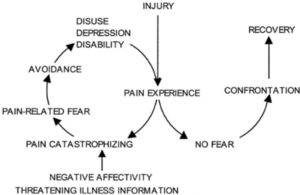What is it?
60 to 70% of people will have an episode of lower back pain in their life. A high proportion of these people will experience chronic pain. An important component to recognize along with chronic pain is the cognitive processes that are involved with symptoms, pain, and outcomes. In fact, depression is commonly experienced with lower back pain, and can have a significant effect on the perception of pain and ability to function in everyday life. Those who demonstrate symptoms of fear, avoidance of movement or depression actually experience more pain in regards to their lower back symptoms, which can significantly affect recovery time. These psychological processes can lead to a type of heightened neurological sensitivity where the nervous system becomes overactive. In this sense, our nerves can send pain signals to the brain, even when we are not necessarily harming the tissues in our spine.
This is not to say that the pain isn’t real. However, it is not correlated with actual structural damage. This is commonly known as “Type III pain,” or neuropathic pain. Up to 35% of Americans have some component of this maladaptive pain. As pictured in the diagram, when we experience an injury, we have acute pain or trauma. Secondarily, we react to it in some way from a psychological perspective. If we become afraid of our pain, the nervous system can become overly heightened in an attempt to avoid painful movements and behaviors. The brain has a top-down effect on our nervous system, and the result is an increased perception of pain with compromised function.
What can you do?
- The first step to breaking the cycle of maladaptive chronic pain is to educate yourself:
- How we cognitively approach our pain has an effect on the sensitivity in our nervous system. This is the mind-body connection, and it relates heavily to our perception of pain.
- Pain does not necessarily equal damage or harm.
- Focus on function and stay active. What are you able to do today that you were not able to do yesterday?
- Perform relaxation techniques such as deep breathing/diaphragmatic breathing.
- Keep a journal of what you are doing/how you feel when you experience more symptoms in your back. This may help you recognize maladaptive thought patterns.
- If you are experiencing symptoms of anxiety/depression, consult with your Doctor.
- Research has shown that Cognitive Behavioral Therapy and Physical Therapy can help reduce and even eliminate persistent chronic Low Back Pain.
By: Mark Sheptock, SPT
Chapman University, Department of Physical Therapy
ProSport Physical Therapy & Performance
2777 Bristol St., Ste. B, Costa Mesa, Ca
Reference for Image:
https://static1.squarespace.com/static/52994853e4b0a6ba0e3606bc/t/53294b01e4b01200be372a86/1395215177106/







